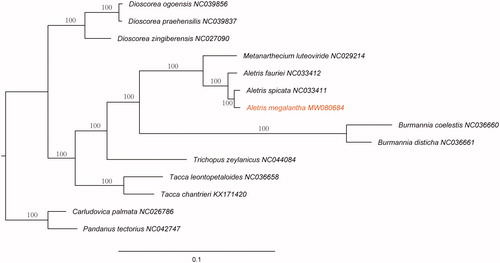Abstract
Aletris megalantha F. T. Wang & Tang is an herbal plant species endemic to Yunnan Province of China. Its complete plastid genome sequence was 154,704 bp in length, with a large single-copy (LSC) region of 83,265 bp, a small single-copy (SSC) region of 18,127 bp, and a pair of inverted repeat regions (IRs) of 26,656 bp. The whole plastid genome encoded 132 genes, including 85 protein-coding genes, 38 tRNA genes, and eight rRNA genes. The overall GC content of A. megalantha plastid genome was 37.4%. Maximum likelihood phylogenetic analysis based on 14 taxa indicated that A. megalantha is evolutionarily close to A. spicata.
Aletris is the largest genus in Nartheciaceae, containing about 20 species, which are disjunctively distributed in eastern Asia and eastern North America (Zhao et al. Citation2012). Aletris megalantha F. T. Wang & Tang is an endemic species from Yunnan Province of China (Wu et al. Citation1997). In the present study, we reported the first complete plastid genome of A. megalantha and performed the phylogenetic analysis with other related species within the order of Dioscoreales based on the plastid genome sequences.
Fresh leaves were collected from Yongde county, Yunnan province of China (99°36′54.40″E, 24°3′54.60″N) and the voucher specimen (Voucher number: YDDXSA036) was deposited in the Herbarium of the Kunming Institute of Botany, Chinese Academy of Sciences, Yunnan, China (KUN). Total genomic DNA was extracted from leaf tissue with an improved 4 × CTAB method (Doyle and Doyle Citation1987). Illumina paired-end (PE) library was constructed, and high-throughput genome sequencing was performed on the Illumina HiSeq X Ten platform. The GetOrganelle v1.7.0 (Jin et al. Citation2020) and the PGA (Qu et al. Citation2019) were used to assemble and annotate the chloroplast genome, respectively, with the whole plastid genome sequences of A. spicata (NC_033411) as reference. The newly annotated complete plastid genome was submitted to GenBank (accession number MW080684).
The complete plastid genome of A. megalantha was 154,704 bp in length, containing a pair of inverted repeats (IRs) of 26,656 bp, a large single-copy (LSC) region of 83,265 bp and a small single-copy (SSC) region of 18,127 bp. The overall GC content of this genome was 37.4% (LSC, 35.3%; SSC, 31.3%; IRs, 42.6%). The whole plastid genome encoded 132 genes, including 85 protein-coding genes, 38 tRNA genes, and eight rRNA genes.
To clarify the phylogenetic position of A. megalantha, the complete plastid genomes of 12 species were selected within the order of Dioscoreales. Another two species from the order of Pandanales were chosen as outgroups. The plastomes of the 14 accessions were aligned using MAFFT (Katoh and Standley Citation2013) plugin in the software PhyloSuite (Zhang et al. Citation2020). A maximum likelihood analysis was performed using RAxML (Stamatakis Citation2006) software with GTR + G model and using the rapid bootstrap with 1000 replicates. The genus Aletris was supported as a monophyly clade by the phylogenetic analysis, and A. megalantha is evolutionarily close to A. spicata (). The pairwise distance between A. spicata and A. megalantha was calculated in MEGA X (Kumar et al. Citation2018) under k-2p model. The pairwise distance (0.0069) indicated that A. spicata and A. megalantha are genetically different. This report provided a valuable resource for the future studies in Aletris and related taxa.
Acknowledgements
We are grateful to Germplasm Bank of Wild Species, Kunming Institute of Botany, Chinese Academy of Sciences for providing the species of Aletris megalantha.
Disclosure statement
No potential conflict of interest was reported by the author(s).
Data availability statement
The genome sequence data that support the findings of this study are openly available in GenBank of NCBI at (https://www.ncbi.nlm.nih.gov/) under the accession no. MW080684. The associated BioProject, SRA, and Bio-Sample numbers are PRJNA680851, SRR13148561, and SAMN16925232 respectively.
Additional information
Funding
References
- Doyle JJ, Doyle JL. 1987. A rapid DNA isolation procedure for small quantities of fresh leaf tissue. Phytochem Bull. 19:11–15.
- Jin JJ, Yu WB, Yang JB, Song Y, dePamphilis CW, Yi TS, Li DZ. 2020. GetOrganelle: a fast and versatile toolkit for accurate de novo assembly of organelle genomes. Genome Biol. 21(1):241.
- Katoh K, Standley DM. 2013. MAFFT multiple sequence alignment software version 7: improvements in performance and usability. Mol Biol Evol. 30(4):772–780.
- Kumar S, Stecher G, Li M, Knyaz C, Tamura K. 2018. MEGA X: molecular evolutionary genetics analysis across computing platforms. Mol Biol Evol. 35(6):1547–1549.
- Qu XJ, Moore MJ, Li DZ, Yi TS. 2019. PGA: a software package for rapid, accurate, and flexible batch annotation of plastomes. Plant Methods. 15:50.
- Stamatakis A. 2006. RAxML-VI-HPC: maximum likelihood-based phylogenetic analyses with thousands of taxa and mixed models. Bioinformatics. 22(21):2688–2690.
- Wu ZY, Chen SK, Chen J. 1997. Flora Yunnanica Tomus 7. Beijing: Science Press; p. 652–653.
- Zhang D, Gao F, Jakovlić I, Zou H, Zhang J, Li WX, Wang GT. 2020. PhyloSuite: an integrated and scalable desktop platform for streamlined molecular sequence data management and evolutionary phylogenetics studies. Mol Ecol Resour. 20(1):348–355.
- Zhao YM, Wang W, Zhang SR. 2012. Delimitation and phylogeny of Aletris (Nartheciaceae) with implications for perianth evolution. J Systemat Evol. 50(2):135–145.

